PRP Treatment for Male Pattern Baldness
Hair shedding, thinning hair, receding hairlines, and other types of balding are common aspects of aging for men. Unfortunately, they can negatively impact self-esteem and confidence, especially in cases of early androgenetic alopecia or male pattern baldness. Until recently, the only options for treating hair loss were daily topical or oral medications. While these treatments can be effective, they require ongoing care and may cause unwanted side effects. Fortunately, recent advances in dermatology have introduced platelet-rich plasma (PRP) therapy for hair regrowth, which involves no downtime and can successfully stimulate hair follicles on the scalp. Dr. Michele Green was among the first dermatologists in NYC to utilize PRP injections as part of her patients’ hair-restoration plans.
Platelet-rich plasma (PRP) therapy is a cutting-edge treatment for hair loss that uses the growth factors in your blood to promote new hair growth and prevent further loss. PRP hair restoration treatment involves using your own blood to stimulate cell regeneration and growth at or near the injection site. Using a centrifuge, your platelets and white blood cells are separated, creating a serum rich in essential growth factors and containing a platelet concentration three times normal. This PRP is then injected into the scalp to reactivate dormant hair follicles, resulting in increased hair count, thicker hair, and stronger hair roots. The procedure is simple, with minimal downtime and discomfort, making it an excellent option for those seeking thicker, fuller hair. If you’re dealing with male pattern baldness and considering PRP treatment, board-certified dermatologist Dr. Michele Green is here to help.
Dr. Michele Green is a globally recognized expert in hair restoration and PRP therapy, with over 25 years of experience helping some of the world’s most discerning clients. Dr. Green uses a holistic approach to hair restoration, tailoring each treatment plan to meet her patients’ individual needs and goals. She is consistently named one of New York City’s top dermatologists by Castle Connolly, New York Magazine, Super Doctors, and The New York Times for her commitment to her patients and her expertise. When you consult with Dr. Green, she will collaborate with you to achieve and maintain thicker, healthier, fuller hair over the long term.
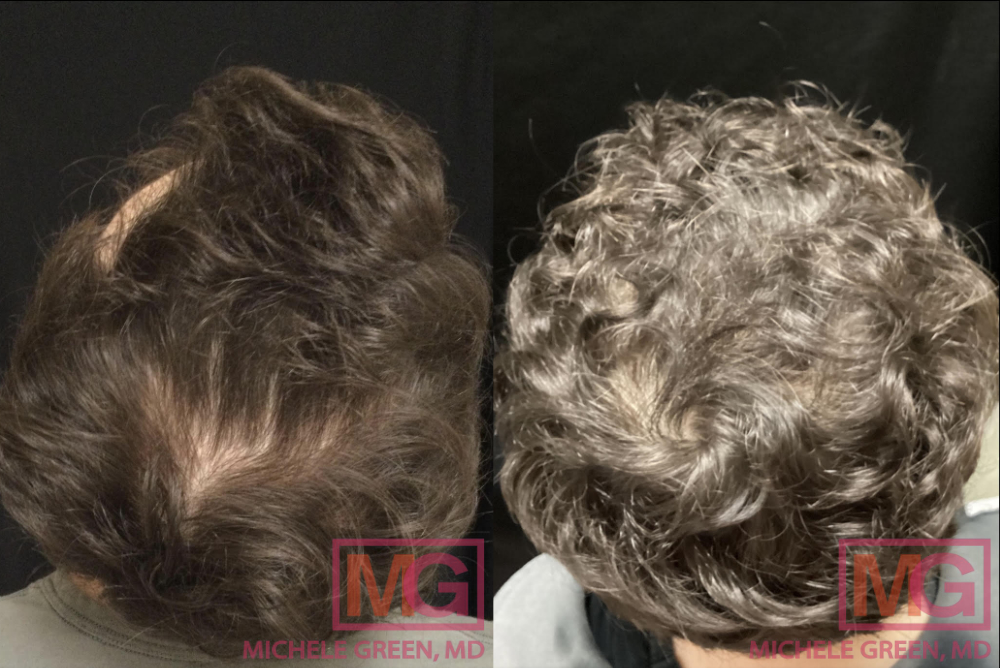
Where does male baldness come from?
Male pattern baldness, also known as androgenic alopecia, is marked by a receding hairline and thinning hair on the crown. It typically starts with hair loss above the temples and on the scalp. Over time, the receding hairline forms an “M” shape, and the thinning continues until the recession and bald spot at the crown meet, creating a “U-shaped” pattern that can lead to partial or complete hair loss. A combination of genetic and hormonal factors often causes male pattern baldness. Those with a family history of hair loss are more likely to develop the condition. Men who experience male pattern baldness often have higher levels of and increased sensitivity to certain androgen, or male, hormones like dihydrotestosterone (DHT), which is why it’s called androgenic alopecia. DHT can shrink hair follicles, weakening the hair and reducing its lifespan. Over time, the shrinking of hair follicles and sensitivity to hormones like DHT can lead to male pattern baldness. Eventually, the hair follicles stop growing new hair altogether.
What is PRP for hair loss in men?
PRP, or platelet-rich plasma, therapy is a unique hair growth treatment that uses growth factors derived from your own blood to promote new hair growth and improve cell proliferation and new cell development. PRP treatment has been explored extensively in dermatology, plastic surgery, musculoskeletal healing, and oral surgery due to its unique wound-healing properties. In recent years, it has been studied as a hair restoration treatment and has shown a significant positive effect on hair growth. When injected into areas of the scalp affected by hair loss, the growth factors improve blood supply to hair follicles and increase hair shaft thickness, helping prevent hair loss and promoting new hair growth.
Patients need an initial series of PRP treatments to achieve the best results. The recommended platelet-rich plasma protocol consists of four treatments, each spaced about four weeks apart. Dr. Green asks patients to return 3 months after their 4th PRP session to assess progress and assess new hair growth. After completing the initial series, most patients undergo regular maintenance treatments every 3, 6, or 12 months to maintain optimal results. Patients appreciate that it is a minimally invasive option with no downtime; they can easily schedule their PRP injections.
How does PRP work for male pattern baldness?
PRP is a serum obtained from a patient’s blood sample, which is spun in a centrifuge to separate the PRP from other blood components like red blood cells. PRP is highly concentrated in platelets packed with growth factors and proteins essential for promoting tissue health and regeneration. Platelets, known for their clotting ability, are rich in growth factors that help revitalize hair follicles, increase the number of small blood vessels near the injection site, and enhance hair growth. PRP’s growth factors also play a key role in stem cell differentiation throughout the body.
The PRP-specific elements that improve hair restoration include:
- Epidermal Growth Factor (EGF): Improves cell growth, as well as collagen and blood vessel formation.
- Fibroblast Growth Factor-2 (FGF-2): Boosts the development of blood vessels and specialized cells.
- Insulin-like Growth Factor-1 (IGF-1): Acts as a protein regulator of standard physiology in almost every cell in the body; also has helpful anabolic effects in adults.
- Platelet-Derived Growth Factor (PDGF): Helps with blood vessel regeneration, as well as cell and skin formation.
- Transforming Growth Factor Beta (TGF-β): Specialized for the growth matrix between cells, as well as bone metabolism.
- Vascular Endothelial Growth Factor (VEGF): Jumpstarts the formation of blood vessels and other cells and tissues necessary for hair growth.
Who is a good candidate for PRP treatment?
A good candidate for PRP hair restoration is someone showing signs of hair thinning or loss. Typically, men who have recently experienced hair loss or are in the early stages of hair loss respond best to PRP treatment. PRP is great for patients interested in or who have already had hair transplant surgery, as it can improve hair quality before the transplant and promote new hair growth afterward. However, PRP is not effective for treating bald areas without hair follicles, as it cannot revive dead follicles or regrow follicles that are no longer present. Additionally, patients with active infections or certain blood disorders may not qualify for PRP therapy. During your consultation with Dr. Green, she will review your medical history and assess your hair loss concerns to determine if you are a good candidate for platelet-rich plasma therapy for hair loss and thinning.
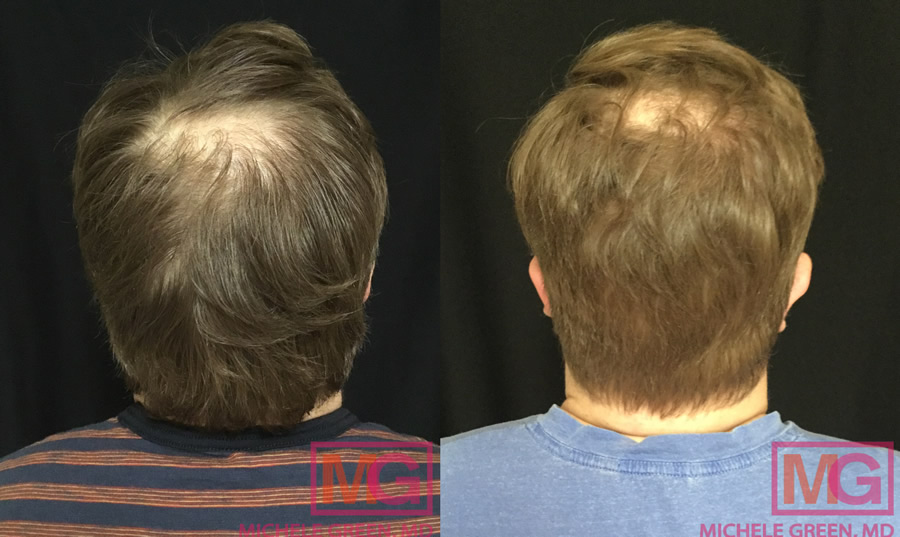
What is the process for PRP treatment like?
The process for PRP treatment of male pattern baldness is straightforward. First, you’ll meet with Dr. Green for an initial consultation to review your medical history and examine your scalp and hair. Dr. Green will collaborate with you to explore all available hair growth options, and together you’ll create a hair restoration plan. On the day of the PRP treatment, a small blood sample will be drawn, spun in a centrifuge, and placed into sterile syringes. Dr. Green will then inject PRP into the scalp’s affected areas, where the serum enhances blood flow to hair follicles and increases hair thickness. Besides helping prevent hair loss, this procedure also stimulates new hair growth. The entire process takes about 30 minutes, and patients can resume normal activities afterward. However, Dr. Green advises avoiding intense exercise on the day of the procedure and waiting until the next day to wash your hair. Alcohol, tobacco, and topical hair styling products should also be avoided for three days following the treatment. When you receive PRP with Dr. Green at her private dermatology office in Manhattan’s Upper East Side, she will provide all the necessary information to help optimize your PRP therapy.
Are there any potential side effects of PRP Treatment?
PRP is a cosmetic procedure that relies on growth factors in the healing process. As a result, there are very few potential side effects. Patients may experience temporary inflammation or tenderness in the treatment area after platelet-rich plasma injections, but this typically resolves within 24 hours. Since PRP is derived from the patient’s blood, there is no risk of an allergic reaction.
How many PRP treatments for hair loss?
Patients typically start with a series of 4 PRP sessions, each scheduled four weeks apart. Following this, Dr. Green reviews the patient’s progress after three months and considers additional PRP treatment. To maintain optimal hair growth, many patients opt for semiannual follow-up treatments. The exact number of PRP sessions recommended can vary depending on individual hair conditions and personal aesthetic goals. Dr. Green applies her expertise to provide the most effective medical advice, diagnosis, and a tailored treatment plan based on your unique hair-loss situation and medical history, aiming to improve hair thickness and stimulate regrowth.
How long does PRP last for hair loss?
PRP can reduce shedding, thicken hair, increase hair density, and promote hair growth with long-lasting results. However, PRP is not a permanent fix for male pattern baldness — if PRP treatments stop for an extended period, baldness will resume. After an initial series of treatments, most patients need a few maintenance sessions each year to maintain their ideal results.
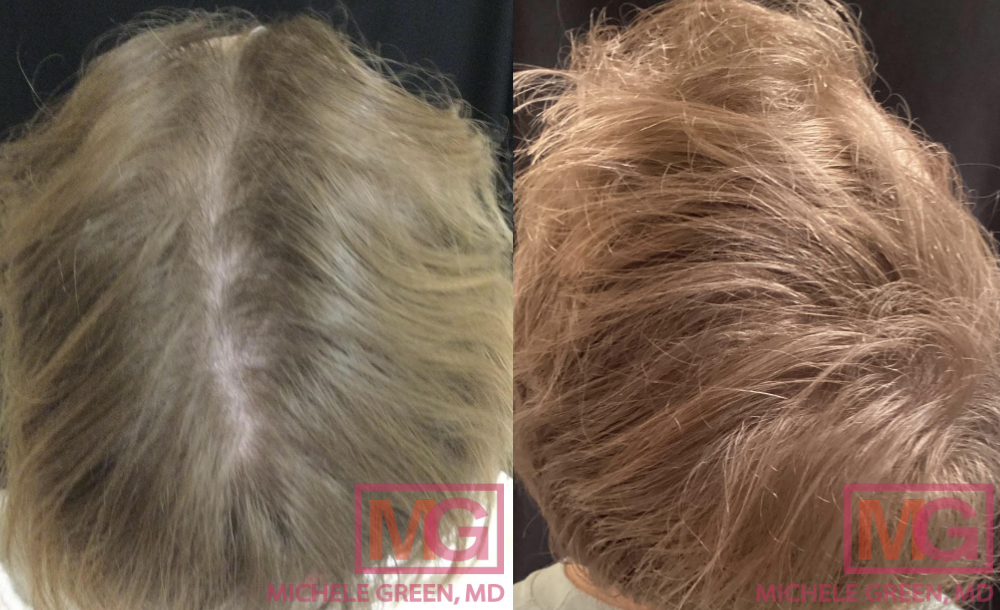
48-year-old treated with PRP for Hair Loss, after four treatments
How effective is PRP for hair loss?
PRP is a highly effective treatment option for preventing hair loss and enhancing hair growth in men experiencing androgenetic alopecia. Multiple studies in the Journal of Cosmetic Dermatology and Aesthetic Plastic Surgery have shown that PRP hair restoration treatment results in a noticeable increase in hair follicle count, a longer growth phase, and thicker hair. Research consistently confirms the effectiveness of PRP treatment in reducing hair thinning caused by androgenic alopecia, telogen effluvium, and alopecia areata. Although larger studies are needed for FDA approval, significant medical evidence indicates that PRP hair treatment is highly effective and has no side effects.
What other treatments can be paired with PRP to treat male pattern baldness?
PRP therapy for hair growth is an innovative option for patients experiencing male pattern baldness. However, depending on the type and severity of hair loss, PRP alone might not be enough for full restoration. Often, Dr. Green combines PRP with topical and oral medications to achieve the best results, resulting in thicker, healthier hair. When you consult with Dr. Green at her private dermatology office in the Upper East Side neighborhood of Manhattan, she will work with you to develop a personalized hair loss treatment plan tailored to your needs and goals.
Topical Minoxidil, commonly known as Rogaine, is the only FDA-approved topical option for hair restoration. It maintains hair in the anagen (growth) phase and reactivates dormant hair follicles, encouraging new hair growth. Originally used as a blood pressure medication, low-dose oral Minoxidil has become a popular off-label treatment among healthcare providers, regarded as safe and effective for hair loss. Oral Minoxidil helps strengthen hair follicles and supports both hair growth and retention.
Propecia, or Finasteride, is an FDA-approved oral medication that blocks the conversion of testosterone into dihydrotestosterone (DHT), a hormone associated with hair follicle miniaturization. It can help improve hair thickness and retention. In some patients, Propecia may cause sexual dysfunction — if this occurs, patients can switch to Dutasteride. Dutasteride is another DHT blocker often prescribed off-label to increase hair density and growth. Unlike Propecia, which inhibits only type 2 5-alpha-reductase, Dutasteride inhibits both types 1 and 2, potentially making it more effective.
Which hair loss treatment is best?
There is no single best treatment for hair loss, as effective results often come from combining different options. The ideal hair loss treatment plan is a personalized combination of treatments selected by an experienced, board-certified dermatologist based on your medical and family history, type of hair loss, and specific needs and goals. Dr. Michele Green, a highly regarded, board-certified dermatologist in New York City with over 25 years of experience, specializes in diagnosing and treating hair loss in both men and women worldwide, helping them achieve thicker, healthier, and fuller hair. During your appointment at her private NYC office, Dr. Green will review your medical and family history and perform a physical examination of your scalp and hair to determine if you’re a good candidate for PRP and identify other treatments that could support optimal hair regrowth.
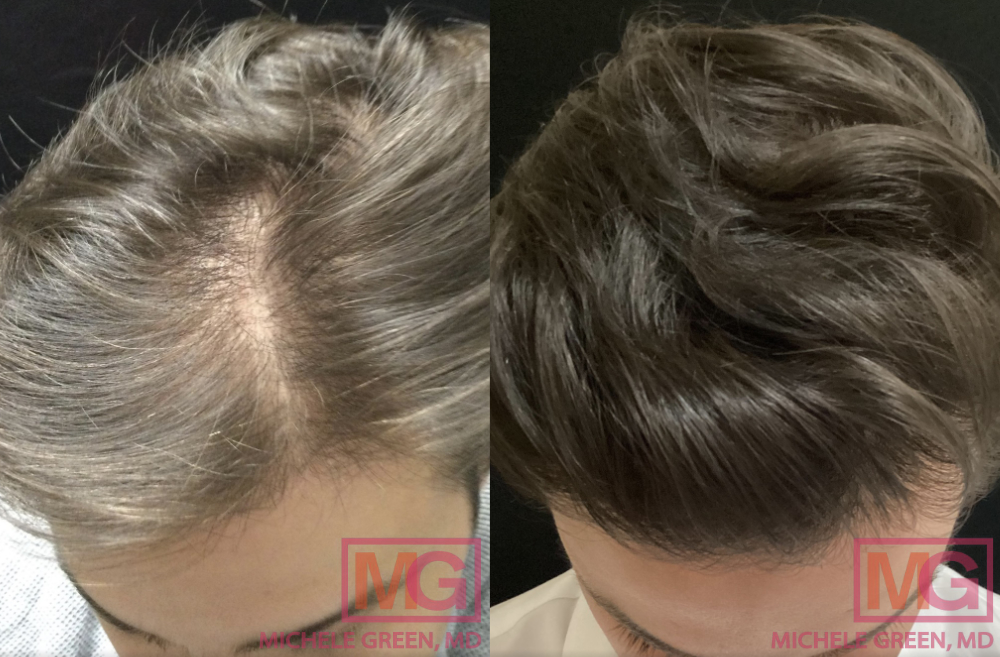
6 sessions of PRP, 14 months
Frequently Asked Questions (FAQs) about PRP and Male Hair Loss
When does male hair loss start?
It is estimated that male pattern hair loss affects about 50 million men in the United States. Some men may begin to experience hair loss as early as their teen years, while others may not experience it until after 50.
Where does male pattern baldness start?
In men, the classic pattern of hair loss involves a receding hairline, temple baldness, and bald spots on the crown or top of the head. Male pattern baldness usually begins with hair loss above the temples and around the crown and vertex. Over time, the hairline recedes, forming a distinctive “M” shape. This thinning pattern continues until the receding hairline and bald area meet, creating a “U”-shaped pattern on the back and sides of the head, eventually leading to partial or total hair loss.
Is hair loss genetic?
One of the most common questions at Dr. Green’s office is, “Is male hair loss hereditary?” Research indicates that this type of male hair loss involves a mix of genetic and hormonal elements. Men with family members who have experienced hair loss, especially among male relatives, are more likely to develop male pattern baldness. Men with androgenic alopecia tend to be more sensitive to dihydrotestosterone (DHT), a hormone important for male features like facial and body hair. In genetically predisposed adults, DHT attaches to androgen receptors in scalp hair follicles, causing them to shrink. This miniaturization weakens the hair and shortens its lifespan, eventually leading to the follicles stopping hair production.
Why has male pattern baldness increased rapidly?
Various factors can lead to increased hair loss, including certain medications, stress, and poor nutrition. Medications such as testosterone replacement therapy can raise DHT levels, causing further hair follicle miniaturization and hair loss. Stress, whether emotional from a family member’s death or physical from recent surgery, can cause rapid hair shedding known as telogen effluvium. This condition occurs when many hairs in the growth phase enter the resting (telogen) phase due to a life stressor. Telogen effluvium can occur alongside male-pattern baldness and usually resolves on its own within 2 to 4 months after the stressor ends. Patients experiencing rapid hair shedding may benefit from a series of PRP treatments and topical or oral medications to prevent further hair loss.
Is male pattern baldness permanent?
Not necessarily. Male pattern baldness involves a gradual thinning of hair follicles. Once a hair follicle dies, it cannot be restored, and the area will remain permanently bald. However, treatments such as PRP, oral medications, or topical Minoxidil can help prevent baldness by slowing further hair loss and promoting hair growth, density, and retention. The best way to mitigate hair loss is to start treatments as soon as you notice hair thinning.
Can PRP cause hair loss?
While rare, PRP can cause telogen effluvium, or hair shedding, due to the shock from the first injection session. Usually, this shedding resolves quickly after the initial treatment, and patients often notice less shedding and increased hair density with subsequent PRP sessions. Patients experiencing shedding after PRP may benefit from using a topical or oral hair loss medication alongside PRP to help reduce shedding and thinning.
When does male pattern baldness stop after beginning PRP treatments?
Hair restoration takes time. Generally, it’s recommended to have 4 PRP treatment sessions spaced roughly 4 weeks apart to achieve the best results. While results vary among individuals, some patients report less shedding and thicker hair after just one or two sessions. However, it typically takes three to six months after starting PRP treatments for the full benefits of PRP to be visible. After an initial series of PRP sessions, many patients continue with quarterly, biannual, or annual maintenance treatments to sustain the benefits. When you receive platelet-rich plasma injections for male pattern baldness with board-certified dermatologist Dr. Michele Green at her private office in Manhattan’s Upper East Side, she will work with you to create a treatment timeline tailored to your specific needs and goals.
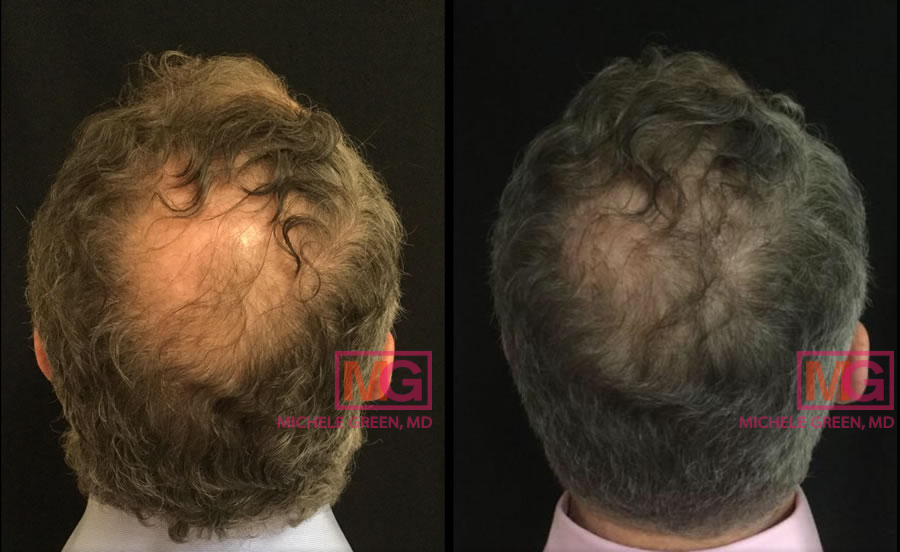
48 year old treated with PRP for Hair Loss, after 4 treatments
How much does PRP for men’s hair loss cost?
The cost of each PRP procedure depends on several factors, including your location, the provider’s expertise, and the number of sessions you choose. Usually, patients start with a series of 4 PRP treatments spaced 1 month apart. PRP injections should be performed by an experienced medical professional with proper training and expertise, such as a board-certified dermatologist, to ensure safe and effective treatment. In New York City, Dr. Michele Green is a board-certified dermatologist who offers PRP injections. During your consultation with Dr. Green, she will review your medical and family history, examine your scalp and hair, and develop a personalized treatment plan for your hair loss. The overall cost of your PRP and hair loss therapies will be determined during this visit.
Why is my hair falling out after PRP?
In some cases, PRP alone might not be enough to stop hair loss. Causes differ and include genetics, hormonal changes, aging, medications, health issues, styling routines, illnesses, and other factors. Depending on the cause of your hair loss, a combination of oral and topical treatments, along with PRP therapy, could be the best approach. Dr. Green will work with you to develop a personalized plan that combines PRP therapy with medications like oral or topical Minoxidil, Propecia, or Dutasteride, all aimed at helping you grow thicker, fuller, and healthier hair.
Is PRP for hair loss permanent?
PRP treatment is a great way to rejuvenate scalp hair follicles, boosting their ability to produce new hair. However, it is not a permanent fix for androgenetic alopecia. Most patients need maintenance sessions after their initial PRP series to achieve optimal results. Dr. Green might recommend that patients return every 3 to 6 months for follow-up PRP treatments, depending on the severity of their hair loss and their response to the therapy. Dr. Green will help you create a personalized schedule for your PRP treatments that fits your specific needs and situation, helping you achieve long-lasting hair restoration.
Is PRP worth it for hair loss?
Yes! Platelet-rich plasma (PRP) injections are a highly effective treatment for men with male pattern baldness. Studies show that PRP injections can increase hair density by preventing hair loss and promoting new growth. PRP enhances the total hair count on the scalp, improves hair follicle health, and makes hair stronger and thicker. The treatment area also benefits from a longer hair-growth phase. PRP is minimally invasive, requires no downtime, and is completely safe because it uses the patient’s own blood. Dr. Green has been providing PRP hair restoration treatments at her private dermatology clinic in New York City for many years. With a series of PRP injections, Dr. Green can help patients achieve denser, fuller, and healthier hair.
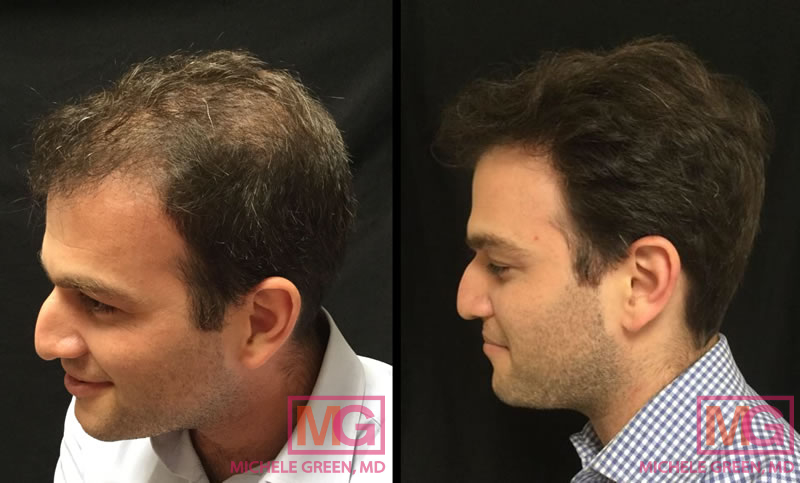
Male with PRP treatment for hair – 4 months
How do I get started with PRP treatment for male pattern baldness today?
Dr. Michele Green, in NYC, was among the first dermatologists to incorporate PRP for hair loss. Platelet-rich plasma (PRP) treatment is an innovative, non-surgical method for treating male pattern baldness. It uses PRP rich in growth factors and proteins to stimulate hair follicles, encouraging hair retention and regrowth. The procedure involves extracting platelet-rich plasma from the patient’s blood and injecting it into the scalp areas affected by hair loss or thinning. PRP therapy promotes natural hair growth, strengthens hair follicles, and helps prevent further loss. It is an excellent option for both preventing and reversing male pattern baldness. After an initial series of treatments, patients can return for regular PRP maintenance sessions to maintain long-lasting, thicker hair. Thanks to PRP injections with Dr. Green, patients can look forward to thicker, fuller hair that lasts.
Dr. Michele Green is a highly respected, board-certified dermatologist with over 25 years of experience. She specializes in non-invasive cosmetic procedures for some of the most discerning clients worldwide, including platelet-rich plasma (PRP) injections, microneedling, Botox, and more. Dr. Green adopts a holistic approach to hair restoration, tailoring each patient’s treatment plan to a personalized combination of oral and topical medications and in-office procedures that best match their needs. She is frequently recognized by Castle Connolly, New York Magazine, Super Doctors, and The New York Times as one of New York City’s top dermatologists, thanks to her dedication and expertise. If you want to slow down male pattern baldness and reverse hair loss signs, PRP treatments might be the answer you’ve been seeking. Contact us online today at 212-535-3088 to schedule a consultation with Dr. Green and learn more about PRP therapy for hair restoration.
 212-535-3088
212-535-3088